city tour bus. I had a chance to go on it when Art and Mary
were here, and I thought it was a really good way to see and
learn about the city. So, I was excited for David to have a
chance to do that too. We got off a couple times to take a closer
look at things.
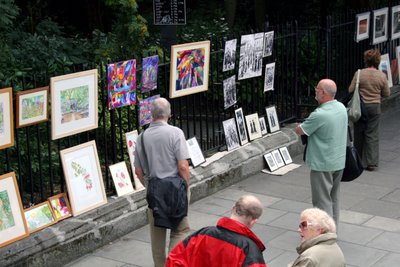
First, we walked around St. Steven's Green where amateur
artists and photographers were showing their work.
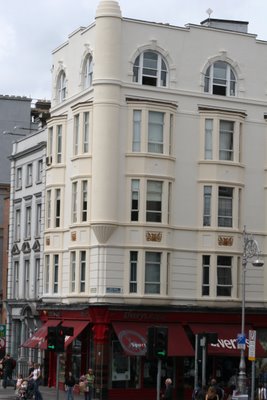
David took this picture once we got back
on the bus. Most everything in Dublin is four
or five stories tall like this building.
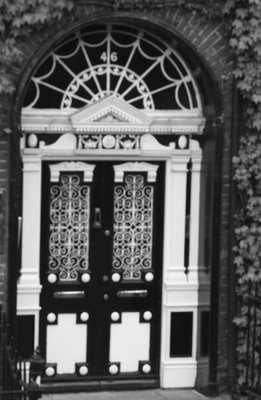
Dublin Door in an area called Georgian Dublin.
The most highly photographed door in the city.
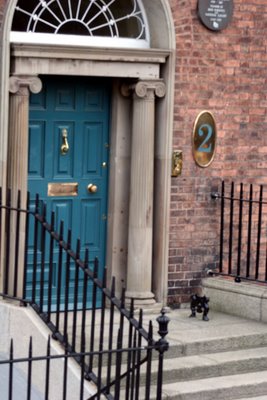
In this area of town, developed in the 18th century,
all the entrances were made with granite walkways,
footscrapers, cast iron gates, and beautiful Dublin
Doors. Georgian Dublin is lined with homes just like
this one, each connecting side by side. Someone
famous lived here, but I can't recall who!
All these places were personal residences at one time.
A special park in the area was designated just for them,
with each owner having a key for entrance. Even though
most of the homes have been turned into businesses,
the park remains a place designated for keyholders.
We also got out at Kilmainham Gaol (jail), one of the
largest unoccupied jails in Europe. The tour covers
some of the most heroic and tragic events in Ireland's
emergence as an independent and modern nation from
the 1780s to 1920s. Opened in the late 18th century it
remained in service until 1924. The jail is most infamous
for being the place where 14 of the rebels where
executed in the early days of May 1916 after the Easter
Rebellion.
You might recall an earlier entry showing the
General Post Office and the monuments on
O'Connell Street. I described a lot of the country's
turbulent history at that time. But as a brief reminder,
some of the people of Ireland took up in rebellion to
try to win their countries independence from Britain.
They armed themselves as best they could and
stormed buildings being used by the British.
James Connolly was the rebels leader.
Patrick Pearce stood on the steps of the GPO
and read the Proclamation of Independence for
the Irish Republic during the Easter Uprising of 1916.
These two men along with 12 other leaders in the
rebellion were held and executed at Kilmainham Gaol.
(I'll talk a little more about them later in the post.)
They were not the only political prisoners held here.
"A continuous procession of patriots were
incarcerated in Kilmainham from its foundation in
1796 until its final closure in 1924," said
dublinks.com. Kilmainham's prisoner profile
was not limited to young adults in political
rebellion however.
Under oppressive British rule, not only were
men jailed here, but women and children, as well.
The youngest prisoner was either six or eight years
of age. (I don't remember exactly.) Most prisoners
were there because of petty theft, largely debtors
and thieves. But often times, people weren't stealing
out of greed and desire for riches. They were acting
out of survival during tough economic times. Children
could be jailed anywhere from one week to five years.
If they were caught picking an apple from someone else's
tree or taking a bit of food from a crop, their punishment
was a jail sentence. One young girl held prisoner there
had stolen a cloak to keep warm.
The very last prisoner was Eamon de Valera.
He was released on July 16, 1924 and later became
the President of Ireland. The jail was then abandoned
and fell into decay. The restoration process was began
by a group of volunteers in the 1960's and was later
finished by the Office of Public Works in the 80's.
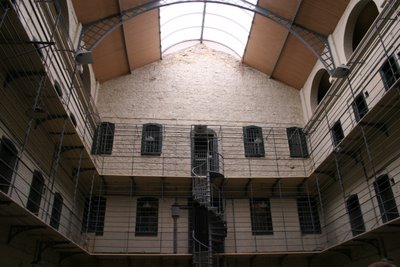
It was built to be a new kind of penitentiary with the
intentions of reform. Here, in the east wing, cells had
small windows. There was also a large ceiling window to
allow light into the main area. The idea was that prisoners
would be reminded of how eager they were to get out and
feel the light of day so when they were released, they
would never want to commit a crime again that would
land them back in jail. Apparently, that didn't work.
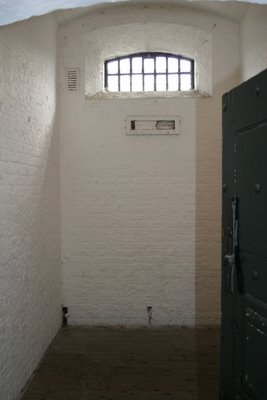
You can see the cell windows here. Again,
this is the east wing. Cells in other areas of the
jail weren't nearly as nice. The original plan was
to assign only one prisoner to a cell. This was
changed in the face of severe overcrowding,
when prison officials crammed as many people as
they could into each one. This cell would have held
five or six prisoners at times.

This was the cell where Grace (Gifford) Plunkett was
held. Before she was a prisoner of Kilmainham, she
was the sweetheart of Joseph Plunkett, a leader in
the fight for an independent Ireland. Joseph was
being held on the second floor of the east wing and
had been sentenced to death. The prison allowed
Grace to come to Kilmainham to marry Joseph in
the jail chapel. As soon as the nuptials were complete,
Grace was escorted out and Joseph was taken to his cell.
She got a message the next day that she could have
ten minutes with Joseph. She hurried there for this
impromptu visit. A guard stood in the cell with the
newlyweds holding a stop watch, timing the ten minute
visit exactly. When the time was up, Grace was escorted
out and Joseph was taken before the firing squad and
executed. Later on, Grace became a prisoner herself in
Kilmainham for her efforts in the fight for Irish
independence.

This is a cell wall in another part of the jail -
not nearly as nice as we saw in the east wing,
pictured above. Each prisoner had a bucket
in their cell which was used as a toilet. They
were allowed an hour or two a day in which to
leave their cell. During this time, they would
clean their bathroom buckets and excercise in
the yard. They were also each given a candle
that had to last them two weeks. If they used
it up in the first four days, they sat in the dark
for the reminder of the two week period. Some
light was pumped into the cell, but only for an
hour or two a day.

The cell shown above and this window are on opposite sides
of the same hallway. It is here that we started to notice how
cold the jail was. Our guide explained that the walls were not
made to insulate, and the cells would be much colder in the
months of autumn and winter. The window you see here was
merely a space to let some light in the hallway. There would
not have been glass in it when the prison was in use. So, the
elements of cold, wind, damp and rain were free to whip in
this part of the jail. At points, Kilmainham was so overcrowded
that people would have been sleeping on the floor in this very
hallway...men, women and children. In addition to bearing
through the conditions of a cold, crowded jail with slop buckets
as toilets, these prisoners did not have the benefit of modern,
warm clothes and shoes.
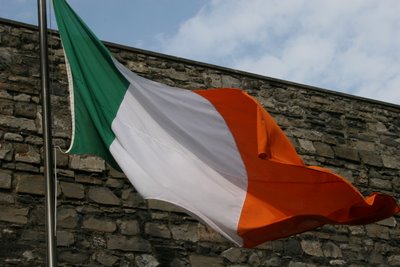
Now, the Irish flag flaps in the execution yard.
The walls surrounding this area were high and had no windows.
This way no one could see in and witness the goings on. The
prisoner to be executed would be standing and fastened to
a pole near the far perimeter of the courtyard. Twelve
executioners would walk in through the gated door and make
two rows. Six of them standing in the back while six others
knelt down in front. Upon receiving the command, all twelve
would fire at the prisoner and exit back through the same
gated door.
Executions of the 14 men killed for leading
the Easter Uprising went as follows:
On May 3, 1916
Patrick Pearse, born 1879.
Thomas MacDonagh, born 1876.
Thomas Clarke, born 1858.
On May 4, 1916
Joseph Plunkett, born 1887.
Edward Daly, born 1891.
Michael O’Hanrahan, born 1877.
William Pearse, born 1881.
On May 5, 1916
John MacBride, born 1865.
On May 8, 1916
Con Colbert, born 1888.
Eamonn Ceannt, born 1881.
Michael Mallin, born 1874.
Sean Hueston, born 1891.
On May 12, 1916
James Connolly, born 1868.
Sean MacDermott, born 1884.
James Connolly, the leader of uprising,
was badly injured during the fighting in Dublin.
Doctors couldn't do anything more for him and
said he would only last a few more days at best.
Nevertheless, he was brought to the execution
yard by ambulance and then carried on a stretcher.
Since he was too weak to stand, he was tied to a chair
and shot to death. A small black cross now stands in
the place where he was killed.
"With the other executed rebels, his body was put into
a mass grave with no coffin," according to
http://www.historylearningsite.co.uk/. "All the
executions of the rebels angered many Irish people
who had shown little support for the rebels during the
rebellion. However, it was the circumstances of Connolly’s
execution that created the most anger. In death, Connolly
and the other rebels had succeeded in rousing many Irish
people who had been, at best, indifferent to the rebels
and their desires when they had been alive," the same
site concludes.

1 comment:
I think tours in new cities are a cool way to see a lot in a short amount of time! I like to do these sort of things too :)
Post a Comment